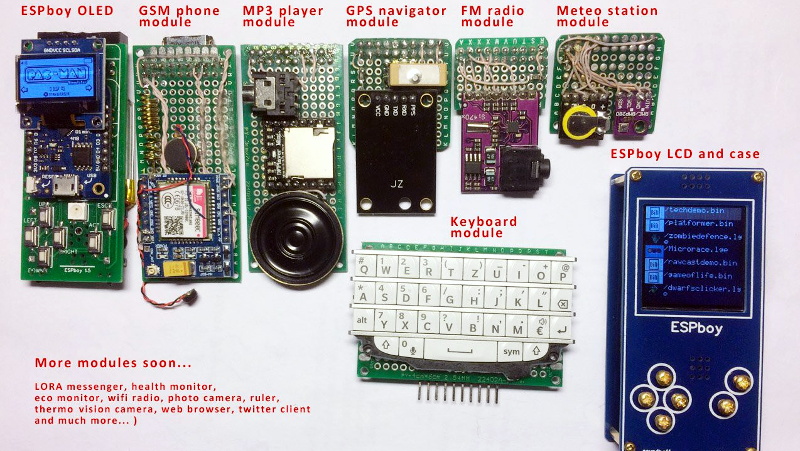Ostensibly the ESPboy is an open-source hackable game engine built as an IoT platform for STEM education and play, but there’s no way [RomanS] could have been inspired by anything other than retro gaming consoles from the near past. For anyone who grew up playing with Tamagotchi pets or Palm Pilots, this project is going to be a major throwback.
The Saint Petersburg-based microcontroller hobbyist utilizes a ESP8266 microcontroller to build a series of modules for different game play modes, including a TFT display, GSM phone, MP3 player, GPS navigator, FM radio, and keyboard module. He has plans to build even more modules, including a LoRa messenger and thermal camera, to really expand the system’s capabilities.
Since the board has built-in WiFi, firmware can be uploaded to the device without a wired connection and compiler. The nature of the project makes the board compatible with the Arduino IDE and Micropython, which makes hacking the software even easier.
A TP4056 battery charging module charges the LiPo, although depending on the battery capacity, the charging current (set by the R3 resistor on the controller) does require some change. A MCP4725 I2C DAC is used for smooth driving the LCD’s backlight. In order to extend the battery life, the battery controller uses sleep mode to periodically wake up to measure and send data, which allows it to extend its battery life without external power. There’s also transistor driven buzzers that provide a little extra feedback to the user when playing games, complete with a variable resistor to adjust the sound volume.
A number of free pins run along the periphery for connecting to other modules, including pins for GPIO extension, sensor adapters, connectors to addressable LEDs, and an extension slot for actuators. For anyone interested in making their own version of the ESPboy, the PCB schematics are accessible online.
Projects like the Arduboy have shown that a small microcontroller-based game system can be equal parts fun and educational, so we’ve been excited to see more of these types of projects popping up during the course of the 2019 Hackaday Prize.






















I have a real problem with hackaday.io based articles. The content on hackaday.io tends to be a thinly disguised advert. Whilst this is a great project – none of the additional modules appear to be documented, and there’s no link to any software repository. Essentially the litmus test for a hackaday ‘hack’ article is sufficient information to be able to reproduce it oneself. As presented, this is really not much more than a teaser for a commercial product, which probably isn’t the author’s intention and is sad.
I have to agree, this article reads like a paid endorsement.
I’m pretty sure these are HackadayPrize2019 showcase articles. An informative way to show what’s being submitted without having to dig through the submissions manually. It’s an advertisement for the event more than the device. I didn’t feel the slimy grip of a paid shill when I read it, but I also figured it was a showcase article. Sometimes it’s not what is said, but what you expect them to say that makes the difference.
I have to agree – to be honest whenever I click a link that is a Hackaday.io one, I stop right there and move on. It’s not just that it may be an advert for a commercial product, but the whole layout of hackaday.io is awful for me as someone who might want to browse a project in the way that I would normally. It almost seems to be arranged to deliberately hide any information you may want to find about it.
Strange terms. What’s the new generation? Newly borns?
When is the new generation over? When the next one is born, next year?
Just stop thinking in generations, even if that’s so common today.
Use something like modern, it doesn’t require to categorize people (in often wrong ways).
I did not payed for this article but anyway thanks to Sharon Lin for paying atttention to my tinkering ). Now it’s not commercial for me , only hobby. But who knows what it could be in future. I’ll be happy to answer the questions or explain the techinal details on the project page.